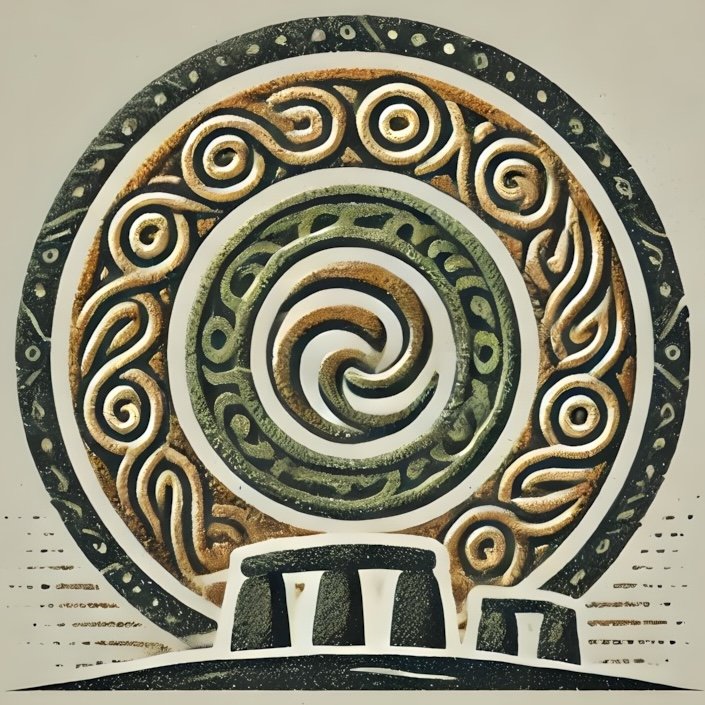The Role of the Ancestors and Cosmic Alignments: Winter Solstice at Newgrange
Introduction to Newgrange
Nestled in the verdant landscape of County Meath, Newgrange stands as a monumental testament to Ireland’s prehistoric past. Built over 5,000 years ago, this passage tomb is older than Stonehenge and the Great Pyramids of Giza, making it one of the oldest known structures in the world. Newgrange is not merely a burial site; it is a complex cultural symbol that intertwines the themes of ancestry, cosmic alignment, and ritual practice. The structure’s most remarkable feature is its alignment with the winter solstice, during which the rising sun illuminates the inner chamber, creating a breathtaking spectacle that has captivated visitors and researchers alike for centuries.
Cosmic Alignments
The winter solstice, occurring around December 21st, marks the shortest day and longest night of the year. For the ancient builders of Newgrange, this celestial event held profound significance. The tomb’s entrance is precisely aligned with the rising sun on this day, allowing sunlight to penetrate the inner chamber for a brief period. This phenomenon suggests that the builders possessed an advanced understanding of astronomy and celestial cycles, integrating their knowledge into the very fabric of their sacred architecture.
The alignment with the winter solstice may symbolize rebirth and renewal, as the return of the sun heralds the gradual lengthening of days. This connection to the solar cycle likely reinforced the community’s relationship with the natural world and their ancestors, intertwining their lives with the rhythms of the cosmos.
Cultural Context of Ancestor Worship
In prehistoric Ireland, ancestor worship was a fundamental aspect of societal structure and spirituality. The reverence for ancestors reflected a belief in the continuity of life and the importance of lineage. At Newgrange, the dead were not merely interred; they were honored and remembered. The act of burial itself was a ritualistic practice, ensuring that the deceased remained a vital part of the community’s identity.
The alignment of Newgrange with the winter solstice suggests that this site served as a focal point for ancestor veneration. The returning sunlight could be seen as a metaphor for the ancestors’ enduring presence, guiding the living through the cycles of life and death. This interplay between the physical and spiritual realms emphasizes the interconnectedness of the community, their ancestors, and the cosmos.
Ritual Practices at Newgrange
The rituals conducted at Newgrange likely revolved around the themes of death, rebirth, and the changing seasons. While specific practices remain elusive due to the lack of written records, archaeological evidence suggests a rich tapestry of ceremonial activities. The inner chamber, adorned with intricate carvings, may have served as a sacred space for offerings and prayers to the ancestors.
During the winter solstice, gatherings at Newgrange would have been a time of communal reflection and celebration. The illuminating rays of the sun could have been interpreted as a divine blessing, reinforcing the community’s connection to their forebears. Feasting, storytelling, and the sharing of oral traditions would have played a significant role in these rituals, fostering a sense of unity and continuity among participants.
Mythological Connections
Irish mythology is replete with tales of gods, heroes, and the ever-present influence of the ancestors. Newgrange, with its celestial alignments and burial practices, can be linked to various mythological narratives. The Tuatha Dé Danann, a race of deities in Irish mythology, are often associated with the Otherworld—a realm where the ancestors reside. The winter solstice may have been viewed as a time when the veil between the worlds was thinnest, allowing for communication and communion with these ancestral spirits.
The mythological connections to Newgrange extend beyond the Tuatha Dé Danann. Stories of the sun god, Lugh, and the goddess Brigid, who represents fertility and renewal, resonate with the themes of the winter solstice. These narratives reinforce the idea that the cycles of nature and the cosmos were deeply intertwined with the lives of the ancient Irish people, shaping their rituals and beliefs.
Archaeological Evidence
Archaeological investigations at Newgrange have unveiled a wealth of information about its construction and use. The tomb’s structure, comprising a large circular mound and a long passageway, is built from local limestone and is adorned with megalithic art, including spirals and zigzag patterns. These carvings are not merely decorative; they likely held symbolic meanings related to the cosmos, ancestry, and the community’s beliefs.
Excavations have also revealed human remains, pottery, and tools, indicating that Newgrange was a site of significant activity. The presence of cremated remains suggests that the rituals conducted here involved both burial and memorialization, further emphasizing the importance of ancestor veneration. The careful alignment of the tomb with celestial events underscores the sophisticated understanding of astronomy possessed by its builders.
The Role of Newgrange in the Landscape
Newgrange is not an isolated monument; it is part of a broader landscape rich in prehistoric sites, including other passage tombs, standing stones, and hill forts. This interconnectedness suggests that Newgrange played a pivotal role in the spiritual and social life of the community. The surrounding landscape was likely imbued with meaning, with each site contributing to a shared cultural narrative.
The positioning of Newgrange within the Boyne Valley, a region steeped in myth and history, further enhances its significance. The valley itself is often referred to as the “Valley of the Kings,” and it is dotted with other important archaeological sites, including Knowth and Dowth. Together, these sites form a complex web of ritual landscapes, reflecting the beliefs and practices of the ancient Irish people.
Modern Interpretations and Legacy
Today, Newgrange stands as a symbol of Ireland’s rich prehistoric heritage, attracting visitors from around the globe. The winter solstice remains a focal point for modern celebrations, drawing people who wish to connect with the ancient traditions of their ancestors. The site has inspired a renewed interest in the study of prehistoric cultures, prompting scholars to explore the connections between ritual, astronomy, and community.
As we continue to unravel the mysteries of Newgrange, its legacy endures, reminding us of the profound relationship between humanity, the cosmos, and the ancestors. The rituals and beliefs of the past continue to resonate in the present, inviting us to reflect on our own connections to the land and the cycles of life.
Visiting Newgrange
For those wishing to experience the magic of Newgrange firsthand, the site is accessible year-round, with guided tours available to provide insights into its history and significance. While the inner chamber can only be accessed by lottery during the winter solstice, visitors can still appreciate the grandeur of the tomb and its surrounding landscape. The visitor center offers exhibitions that delve into the archaeology and mythology of Newgrange, enhancing the experience for those eager to explore Ireland’s prehistoric past.
In visiting Newgrange, one embarks on a journey through time, connecting with the ancestors and the cosmic alignments that shaped their lives. This sacred site invites reflection on the enduring legacy of those who came before us, reminding us of the timeless rhythms of nature and the importance of honoring our roots.
meta –

